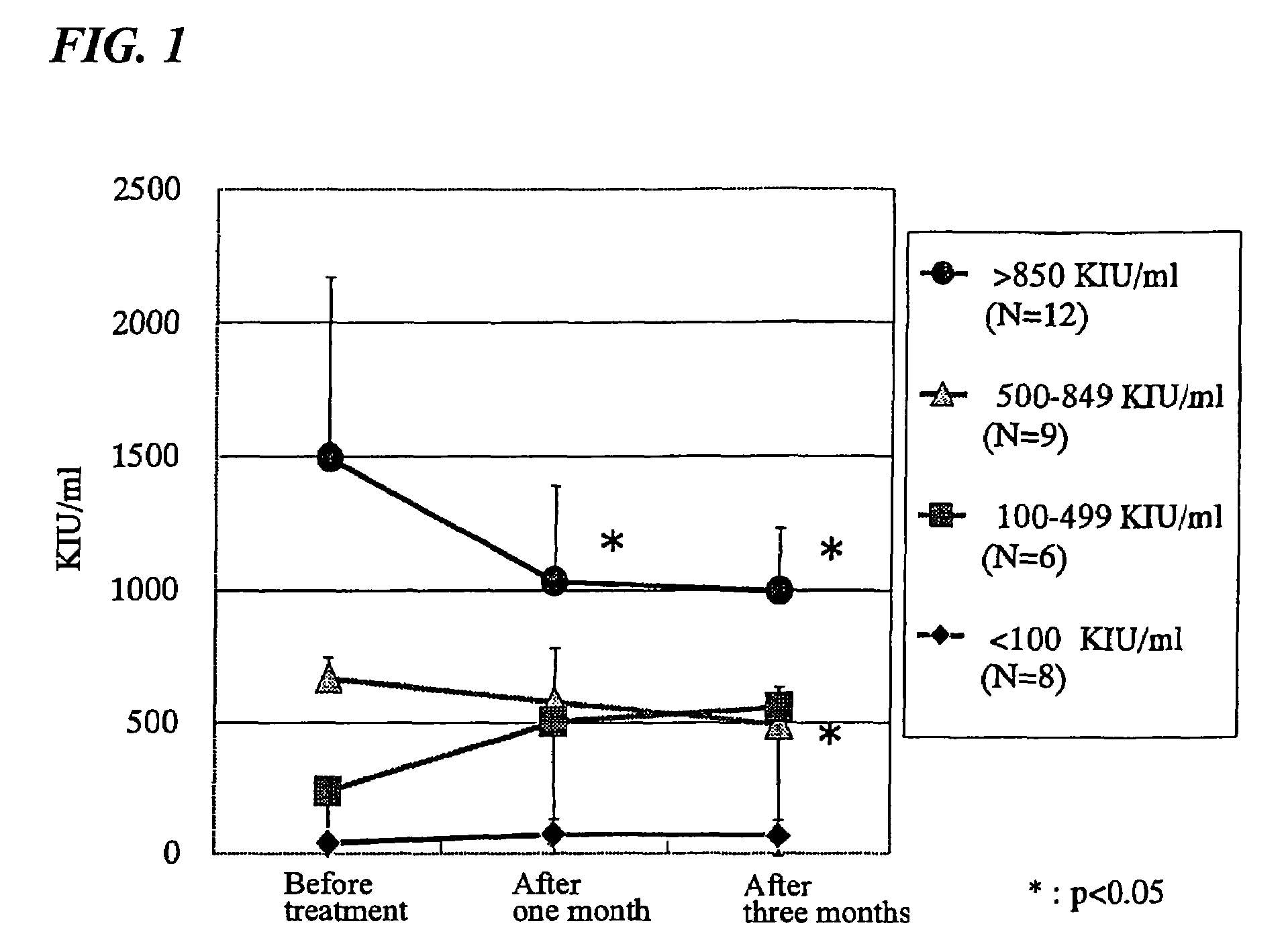Composition for treating hepatitis C
a technology for hepatitis c and composition, applied in the direction of biocide, plant/algae/fungi/lichens, drug compositions, etc., can solve the problems of inability to complete recovery, hepatitis c hepatic damage and slight symptoms, and the acute hepatitis period is not clear, so as to improve the subjective symptoms, improve or relieve the symptoms of chronic hepatitis c, the effect of decreasing the amount o
- Summary
- Abstract
- Description
- Claims
- Application Information
AI Technical Summary
Benefits of technology
Problems solved by technology
Method used
Image
Examples
example 1
(1) Measurement of the Amount of Hepatitis C Virus RNA in Chronic Hepatitis C Patients
[0037]26 chronic hepatitis C patients (13 men and 13 women range in age from 28 to 80 (the average age was 59.0)) receiving conventional treatment that exhibited a high amount of RNA at initiation of the testing were tested. A commercial product of the composition of the present invention known as InterPunch® (manufactured by Sanwell Co., Ltd.) was administered to the subjects in an amount of two packages (1.5 g per package) daily for three months. Before administration, and one month and three months after administration, the subjective symptoms, objective symptoms, and general biochemical measurement of the patients were observed and the HCV-RNA amounts were measured.
(2) Test Results
[0038]Four of the six patients exhibiting the subjective symptom of general malaise and one patient exhibiting a bloating sensation ceased to exhibit the symptoms after administration of the drug for one month. Two of...
example 2
(1) Subjects
[0041]An open label examination of 50 registered patients receiving treatment for chronic hepatitis C including the 26 patients of Example 1 (26 males and 24 females, aged 28-80, with an average age of 59.0±10.6 (SD)) was carried out. The allocation standard was determined by the physician in charge and consent was obtained from each patient. The subjects were separated into group 1 (40 subjects) and group 2 (9 subjects) according to the HCV serotype, with one subject unclassified. 24 of the subjects had a history of IFN treatment.
[0042]Four subjects were removed from the experiment because administration was not proper, four subjects were removed from the experiment due to missing data, three subjects were removed from the experiment because they were administered IFN within six months of the start of the experiment, two subjects quit the experiment of their own accord, one subject was removed from the experiment because he began IFN treatment during the experiment, and...
example 3
[0069]5.0 g of Cucurbita moschata, 3.0 g of Carthamus tinctorius, 1.0 g of Plantago asiatica, 3.0 g of Lonicera japonica, 67 g of lactose, and 16 g of starch were mixed thoroughly in a vertical type blender. The mixture was kneaded with a kneading solvent that had been prepared in advance by dissolving 2 g of hydroxypropyl cellulose and 5 g of capric acid triglyceride into 40 g of 85% ethanol solution. The kneaded mixture was granulated in a basket-type granulator (screen diameter of 1 mm). The granules which were passed through a 14 mesh sieve were dried to obtain column-shaped granules. The above components were thoroughly mixed with mannite; hydroxypropyl cellulose, magnesium metasilicate-aluminate, aspartame, and fragrance to obtain 12 packages of fine granules (refer to JP 2000-231584).
[0070]Compositions with various component ratios (wt %) can be prepared in the same manner as that of Example 4 below.
[0071]
TABLE 4Composition exampleFormulationCucurbitaCarthamusLoniceraexamplem...
PUM
 Login to View More
Login to View More Abstract
Description
Claims
Application Information
 Login to View More
Login to View More - R&D
- Intellectual Property
- Life Sciences
- Materials
- Tech Scout
- Unparalleled Data Quality
- Higher Quality Content
- 60% Fewer Hallucinations
Browse by: Latest US Patents, China's latest patents, Technical Efficacy Thesaurus, Application Domain, Technology Topic, Popular Technical Reports.
© 2025 PatSnap. All rights reserved.Legal|Privacy policy|Modern Slavery Act Transparency Statement|Sitemap|About US| Contact US: help@patsnap.com

